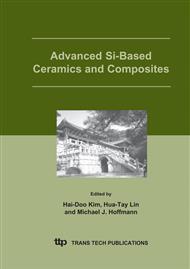p.282
p.293
p.299
p.311
p.317
p.323
p.329
p.335
p.340
Nano Stress Measurement and Microstructural Characterization of Silicon-Based Optical Devices Using Their Native Luminescence
Abstract:
Electron-stimulated luminescence (cathodoluminescence, CL, henceforth) assessments can be quantitatively used in silicon-based optical devices for obtaining information about: (i) the residual stresses piled up during manufacturing; and (ii) the micro/nanoscopic structure of the device. In the present study, a quantitative characterization is presented from a micrometer to a nanometer scale using CL bands of some optically active defects existing within the nanostructure of optical devices. In particular, some CL bands, peculiar of oxygen-related defects in silica, have shown high stress sensitivity and thus were suitable for residual stress assessments. Knowledge of residual stresses can be quantitatively established from the examination of selected spectral shift characteristics (piezo-spectroscopic method). The correlation coefficient between stress and wavelength-shift of characteristic luminescence bands was systematically evaluated by stress calibrations. The piezo-spectroscopic approach shows promises as a valuable characterization tool, suitable for routinely inspecting micromechanical features and, thus, for optimizing low-loss, highquality optical devices.
Info:
Periodical:
Pages:
317-322
Citation:
Online since:
June 2005
Authors:
Keywords:
Price:
Сopyright:
© 2005 Trans Tech Publications Ltd. All Rights Reserved
Share:
Citation:


